

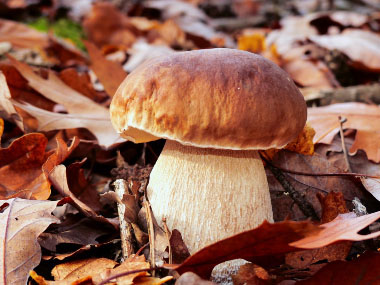
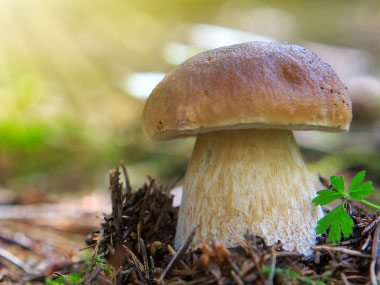
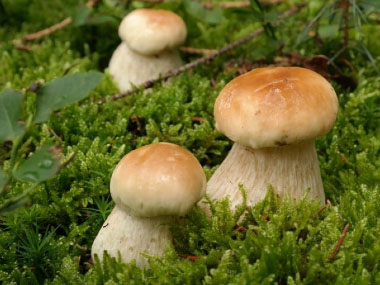
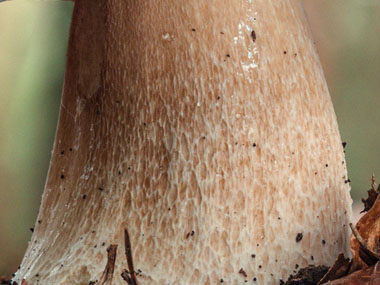
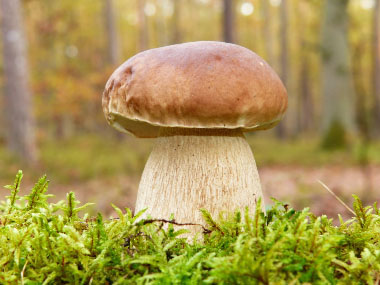
Do not eat any fungi that has not been properly identified by a qualified professional, some are DEADLY when ingested. All edible wild fungi MUST be cooked.
King Bolete is in the Boletaceae family. This is a very popular, tasty, meaty mushroom that grows in many countries. It has many names such as king, cep, porcini, and penny bun. This popular mushroom has been drawn, painted, and sculpted by countless artists. King boletes are often very large and stately with a thick club shaped stem, thick cap and an impressive appearance. They are one of the finest edible mushrooms. Although it can be used in any recipe calling for cultivated (button) mushrooms, they truly excel in risotto dishes and omelettes.
Type
Distinguishing Features
The cap, on average, is 5cm to 25cm (2" to 10") across, smooth, and quite thick. It can also be sticky in damp weather. The cap is convex becoming flat at maturity. The color is variable from light brown to reddish brown. It is dense when young becoming a spongy with age with a pleasant aroma. The stem (stipe) is thick and club-shaped. When young it is often almost as thick at the bottom as the cap is wide. Often the stem is slightly reticulated; with the reticulation most pronounced near the top. The color varies from whitish cream to reddish brown. The stipe can get to 10cm (4") in diameter at the widest point. When cut, the flesh is generally white all around, but occasionally has some yellow stains near the base of the stalk.
Height
These mushrooms grow anywhere from 10cm to 20cm (4" to 8") tall.
Habitat
They are frequently found at the edges of clearings in broad-leaved and coniferous forests. Boletes cannot survive without trees. (The roots of trees extend a long way, so you could find these boletes growing metres away from the trunk of its partner tree.)
Spore Print
Olive-brown.
Season
King Bolete season, typically, is from September to November, especially after heavy rainfalls to the first frost. They are widely distributed throughout forests in many areas across the U.S. and Canada. This bolete co-exists with Amanita muscaria, so the brightly colored poisonous amanita is a good indicator of the king bolete presence.
Gills
No gills. Tubes (pores) are present under the cap, they are white, turning yellowish as they age.
Edibility
King Boletes are sought-after edible boletes. They are a great source of dietary fiber, protein, and minerals such as selenium, manganese, zinc, and copper. Also, they contain several of the B vitamins, vitamins D, and C, as well as flavonoids, antioxidants and phenolic compounds. Always cook - never eat raw.
Other Name
Porcini Mushrooms.
Recipes
Boletus huronensis is a look-a-like and can cause gastric upset if consumed. The main differences are: the stipe lacks reticulation, and: the pore surface is yellow at first, becoming olive-yellow.
To support our efforts please browse our store (books with medicinal info, etc.).
Winter Survival Food Handbook

PDF Plant Magazines
Types of Wild Food
Geographic Zones Seasons
Disclaimer
EdibleWildFood.com is informational in nature. While we strive to be 100% accurate, it is solely up to the reader to ensure proper plant identification. Some wild plants are poisonous or can have serious adverse health effects.
We are not health professionals, medical doctors, nor are we nutritionists. It is up to the reader to verify nutritional information and health benefits with qualified professionals for all edible plants listed in this web site. Please click here for more information.
Why Edible Wild Food?
- Food costs are rising
- Free, wild food is readily abundant
- Wild food adds nutrition to your diet
- Wild food can help treat various medical conditions





